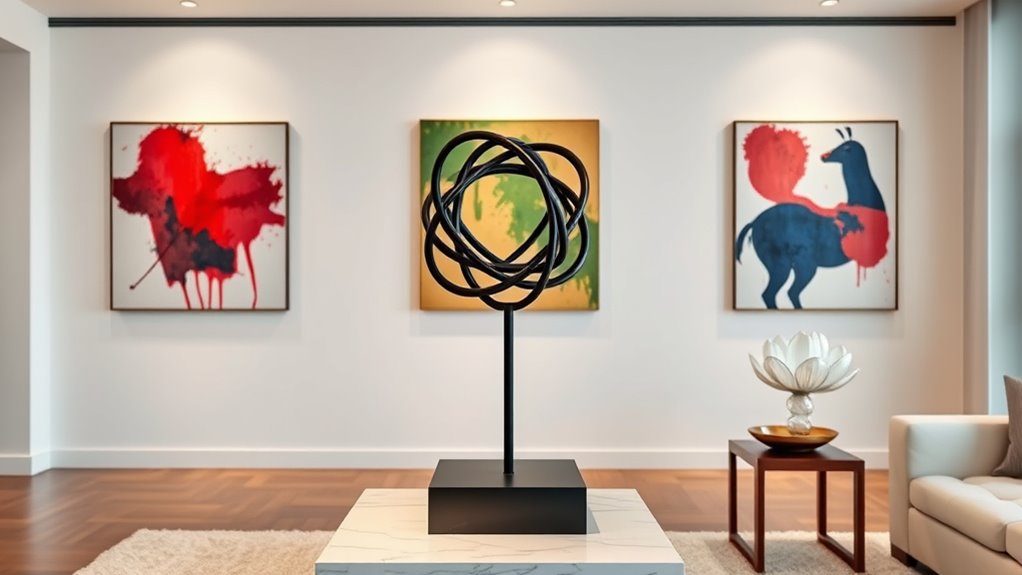To showcase your personal taste, thoughtfully incorporate artwork and sculptures into your space by selecting pieces that reflect your style and mood. Place large artworks above furniture or in key corners for focus, and group smaller pieces for visual interest. Use proper lighting to highlight textures and details, creating shadows that add depth. Balance placement and style with your overall decor, turning your home into a truly unique and expressive environment—discover how careful placement can elevate your interior design.
Key Takeaways
- Select artwork and sculptures that reflect your personal style and complement your overall interior theme.
- Strategically place prominent pieces above furniture or in focal areas for visual impact.
- Use lighting to highlight textures, forms, and details, enhancing the personal expression of each piece.
- Group smaller artworks to create gallery walls that showcase your taste and stimulate curiosity.
- Balance visibility and harmony to ensure your art pieces feel integrated and elevate the space’s character.

Have you ever wondered how to seamlessly integrate artwork and sculptures into your space? The key lies in thoughtful art placement and understanding different sculpture styles. When you approach your interior with intention, your personal taste can shine through in a way that transforms your environment into a reflection of who you are. Art placement isn’t just about hanging pictures on the wall; it’s about creating a visual dialogue that balances aesthetics with function. For example, large paintings or bold sculptures can become focal points if positioned correctly, such as above a sofa or in a prominent corner. Conversely, smaller pieces can be grouped to create a cohesive gallery wall that invites curiosity and conversation. The goal is to arrange artwork where it naturally draws attention without overwhelming the space.
Choosing the right sculpture styles is equally important. Different sculpture styles evoke distinct moods and complement various interior themes. Modern sculptures with sleek lines and minimalist forms work well in contemporary settings, adding a sense of sophistication and clean elegance. Traditional sculptures, often characterized by detailed craftsmanship and classical motifs, can enhance more timeless or eclectic interiors. Abstract sculptures, with their dynamic shapes and open-ended interpretations, bring an element of intrigue and modernity. When selecting sculpture styles, consider the existing decor and the atmosphere you want to cultivate. Mixing styles can also create visual interest, provided you maintain harmony through color, scale, or material. Additionally, understanding the different sculpture styles can help you select pieces that resonate with your personal taste, making your space uniquely yours.
Placement strategies should consider both scale and lighting. Larger sculptures deserve ample space to breathe, so avoid crowding them with other decor. Position them where they can be appreciated from multiple angles, such as in a spacious entryway or living room corner. For smaller sculptures, think about display cases, shelves, or pedestal stands that elevate their prominence. Proper lighting enhances sculpture details and creates shadows that add depth. Spotlights or directional lighting can highlight textures and forms, making your sculptures more enthralling. Remember, the goal is to make your artwork and sculptures feel integrated, not isolated. They should complement the overall design and reflect your personal taste without clashing with other elements.
Ultimately, the art placement and sculpture styles you choose reveal your personality and aesthetic preferences. By carefully selecting and positioning your pieces, you craft a space that’s uniquely yours—dynamic, inviting, and full of character. It’s about finding the right balance between visibility and harmony, so your artwork becomes an authentic extension of your style. When you invest thought into how you display your sculptures and artwork, you create a home that’s both visually stunning and deeply personal. Recognizing the importance of art placement can significantly enhance the overall ambiance and cohesion of your interior design.
Frequently Asked Questions
How Do I Protect Artwork From Sunlight and Environmental Damage?
To protect your artwork from sunlight and environmental damage, you should use UV protection on windows and glass to block harmful rays. Keep the climate controlled by maintaining stable temperature and humidity levels, preventing warping or fading. Regularly inspect your pieces for signs of damage and avoid placing them in direct sunlight or near heat sources. Proper storage and using protective covers when needed also help preserve your artwork’s beauty and longevity.
What Are Budget-Friendly Ways to Display Sculptures Effectively?
To display sculptures on a budget, consider DIY framing or wall mounting options. You can create custom bases with affordable materials like wood or foam board, and secure sculptures with strong adhesive or hooks. Wall mounting works well for smaller pieces, using simple brackets or picture hangers. These methods keep your sculptures protected and visually appealing without spending a lot, letting your personal taste shine through creatively.
How Can I Integrate Artwork Into Small or Awkward Spaces?
You can maximize small or awkward spaces by creating gallery walls, which add visual interest and make the area feel intentional. Use wall niches to display artwork or sculptures, giving them a dedicated spot without cluttering the space. Arrange your pieces at different heights, and opt for lightweight frames or mounts to keep the display flexible. This approach transforms tricky spots into engaging focal points that reflect your personal style.
What Lighting Options Best Highlight Sculptures and Artwork?
You should use gallery lighting with adjustable spotlight techniques to highlight sculptures and artwork effectively. Position spotlights at angles that enhance textures and details, avoiding glare. Opt for LED options for bright, consistent illumination with minimal heat. Use dimmers to control light intensity, creating the desired ambiance. Properly angled lighting draws attention to key features, making your art stand out while complementing your space’s unique character.
How Do I Choose Art That Complements My Existing Decor Style?
Did you know that 85% of homeowners say artwork influences their decor style? To choose art that complements your existing decor, focus on color coordination and thematic consistency. Pick pieces that echo your room’s color palette or themes, creating harmony. Consider how the artwork’s style aligns with your decor’s vibe—modern, rustic, or minimalist—to make sure it enhances your space seamlessly and reflects your personal taste.
Conclusion
Incorporating artwork and sculptures transforms your space into a reflection of your soul, much like a garden blooms with personal touches. When I added a vibrant sculpture to my living room, guests immediately noticed its story—much like a favorite book on a shelf. Just as art breathes life into a room, your personal taste creates a unique tapestry that invites others in. Embrace your choices, and watch your space become a true reflection of you.









